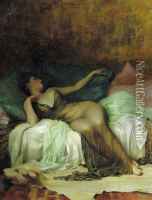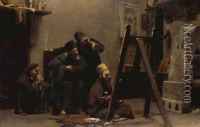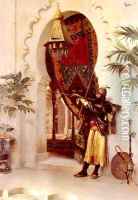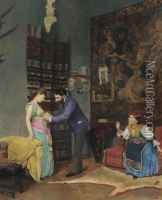Theodore Jacques Ralli Paintings
Theodore Jacques Ralli was a Greek painter, born in Constantinople (modern-day Istanbul), in 1852. He belonged to the distinguished Ralli family, who were part of the Greek diaspora in the Ottoman Empire. Ralli was exposed to art at a young age and developed a passion for painting. He moved to Paris to study art, which was the epicenter of the art world at the time. Ralli trained under renowned academic painters such as Jean-Léon Gérôme and Léon Bonnat, who were influential in shaping his style and technique.
Ralli's work is often categorized as Orientalist, as he frequently depicted scenes from the daily life and culture of Eastern Mediterranean countries. His subjects included landscapes, genre scenes, and portraits, often characterized by meticulous detail, vibrant colors, and a keen observation of light and shadow. He was particularly interested in portraying the people and customs of his native Greece, as well as those of Egypt and Turkey.
Throughout his career, Ralli traveled extensively, which allowed him to study various cultures and bring authenticity to his paintings. His travels not only inspired his artistic themes but also provided him with the opportunity to exhibit his works across Europe. He participated in numerous exhibitions, including the Paris Salon, and received recognition for his artistic contributions.
Ralli's paintings reflect a harmonious blend of academic art training and a fascination with ethnographic themes. He was adept at capturing the essence of the scenes he depicted, often imbuing them with a sense of romanticism while maintaining ethnographic accuracy. His work was well-received by both critics and collectors during his lifetime, and today, his paintings can be found in various museums and private collections around the world.
Theodore Jacques Ralli died in 1909, leaving behind a rich legacy of paintings that continue to be celebrated for their beauty and historical value. His artistic legacy is recognized as an important part of the Orientalist movement and provides a window into the cultures of the Eastern Mediterranean region during the late 19th and early 20th centuries.

















